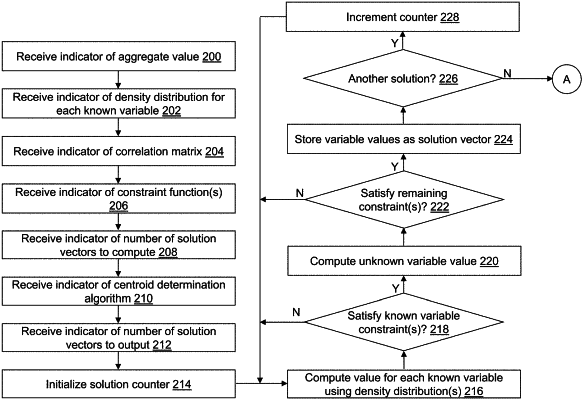| CPC G06F 18/24137 (2023.01) [G06F 17/11 (2013.01); G06F 18/23213 (2023.01); G06F 18/2411 (2023.01); G06Q 10/0635 (2013.01)] | 30 Claims |

|
1. A non-transitory computer-readable medium having stored thereon computer-readable instructions that when executed by a computing device cause the computing device to:
(A) compute a first value for a known variable using a predefined density distribution function;
(B) compute a second value for an unknown variable using the computed first value, a predefined correlation value, and a predefined aggregate value, wherein the predefined correlation value indicates a correlation between the known variable and the unknown variable;
(C) repeat (A) and (B) until a predefined number of solution vectors is computed, wherein a solution vector is the computed first value and the computed second value;
(D) compute a centroid vector from solution vectors computed by repeating (A) and (B) in (C);
(E) determine a predefined number of closest solution vectors to the computed centroid vector from the solution vectors;
(F) select a first solution vector from the predefined number of closest solution vectors;
(G) define a first aggregate value that is a value of the known variable in the selected first solution vector;
(H) compute a third value for a second known variable using a second predefined density distribution function;
(I) compute a fourth value for a second unknown variable using the computed third value, a second predefined correlation value, and the defined first aggregate value, wherein the second predefined correlation value indicates a correlation between the second known variable and the second unknown variable;
(J) repeat (H) and (I) until the predefined number of solution vectors is computed to define second solution vectors, wherein a second solution vector is the computed third value and the computed fourth value;
(K) compute a second centroid vector from the defined second solution vectors;
(L) determine a second predefined number of closest solution vectors to the computed second centroid vector from the defined second solution vectors;
(M) define a second aggregate value that is a value of the unknown variable in the selected first solution vector;
(N) compute a fifth value for a third known variable using a third predefined density distribution function;
(O) compute a sixth value for a third unknown variable using the computed fifth value, a third predefined correlation value, and the defined second aggregate value, wherein the third predefined correlation value indicates a correlation between the third known variable and the third unknown variable;
(P) repeat (N) and (O) until the predefined number of solution vectors is computed to define third solution vectors, wherein a third solution vector is the computed fifth value and the computed sixth value;
(Q) compute a third centroid vector from the defined third solution vectors;
(R) determine a third predefined number of closest solution vectors to the computed third centroid vector from the defined third solution vectors; and
(S) output the determined second predefined number of closest solution vectors and the determined third predefined number of closest solution vectors as disaggregated solutions given the predefined aggregate value.
|